To tailor a vintage kimono, start by measuring key areas like length, hip circumference, and sleeve length. Use sharp fabric scissors and tailor's chalk for precise cutting, ensuring you respect the garment's intricate design and material. When hemming, trim carefully and consider using hand blindstitching for a polished finish. Employ techniques like stitch-in-the-ditch for clean seams and decorative stitches to highlight unique patterns. Besides improving fit, this process revitalizes the kimono while preserving its heritage. Explore diverse styles of kimonos and tailoring methods to reveal their potential for unique personalization and enhanced wearability.
Purpose of Tailoring a Kimono
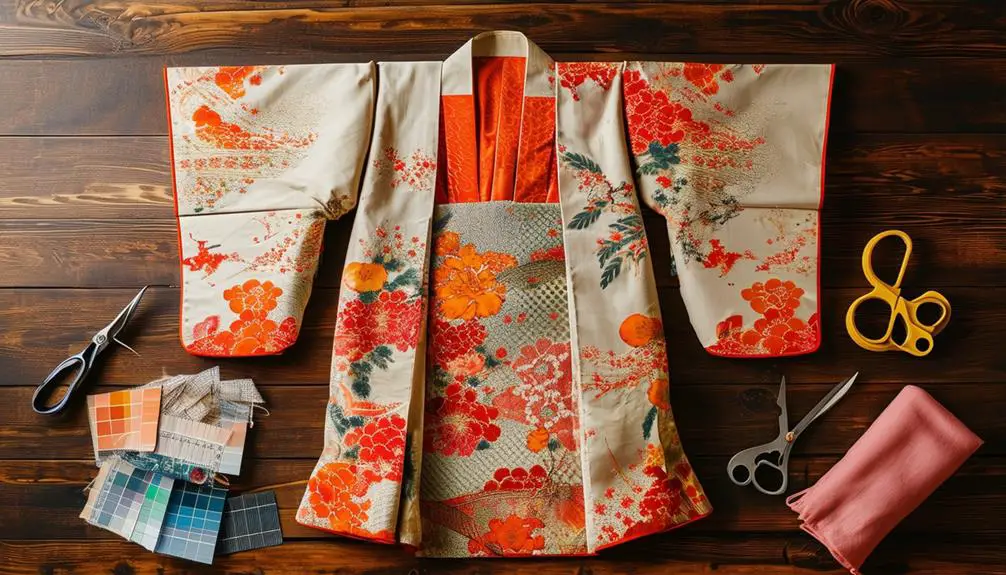
Tailoring a vintage kimono serves multiple essential purposes that enhance both its functionality and aesthetic appeal. When you tailor a vintage kimono, you create a more personalized fit, making it wearable, especially if the original garment is too long or has been outgrown. This adjustment not only revitalizes the piece but also respects its historical significance, allowing you to enjoy it in contemporary settings.
Understanding the vintage clothing trends by era can further inform your tailoring choices, guaranteeing that the final look remains true to the garment's origins.
Moreover, proper tailoring maintains the structural integrity and aesthetic charm of the vintage kimono. By making thoughtful adjustments, you assure it remains true to its traditional form while adapting it for various wearing styles—be it as a casual robe or formal attire. This versatility considerably expands the garment's usability.
Additionally, the off-cuts from the tailoring process can be creatively repurposed into accessories like belts, scarves, or ties, preserving the fabric's heritage. This approach not only reduces waste but also adds a personal touch to your wardrobe.
Ultimately, tailoring a vintage kimono transforms it into a cherished piece that blends historical elegance with modern practicality, making it a valuable addition to your collection.
Essential Tools and Materials
When starting on the journey of tailoring a vintage kimono, you'll need a selection of essential tools and materials to guarantee a successful transformation. Sharp fabric scissors are vital for precise cutting, allowing you to navigate intricate patterns without fraying.
Tailor's chalk or fabric markers help you make accurate markings, assuring you can visualize alterations before committing. Don't forget pins or weights to secure the fabric layers during the cutting process, as stability is key to a smooth operation.
A sewing machine can greatly enhance your efficiency, but hand sewing with natural fiber threads like silk or cotton maintains the fabric's integrity and adds a touch of tradition. A measuring tape is indispensable; it confirms you account for the necessary seam allowance, allowing for adjustments that achieve a perfect fit.
You'll also require a low-temperature iron to delicately press silk and vintage linings, avoiding damage to sensitive materials like acetate.
Additional tools like a seam ripper for removing stitches and a needle threader for hand sewing can be invaluable, especially when working with delicate fabrics. Equip yourself with these essentials, and you'll be well-prepared for your tailoring adventure.
Measuring Your Kimono

Having gathered your tools and materials, you're ready to begin the measuring process for your vintage kimono. Start by measuring your height, known as Mitake, which is vital for determining the overall length of the garment. If your kimono doesn't have a miyatsuguchi, it'll typically fall at ankle length, while one with it should match your height perfectly.
Next, measure your hip circumference, ensuring you have a comfortable fit around the outer fabric. To get the sleeve length, or Yuki take, hold your arm at a 45° angle. This position reflects how the kimono will drape when worn, so accuracy is key.
Don't overlook additional measurements like Kata haba, Yukisode haba, and Ushiro haba. These dimensions help achieve a tailored fit and balanced proportions, ensuring your kimono looks as good as it feels.
Techniques for Hemming
Achieving a polished finish on your vintage kimono hinges on mastering the art of hemming. To begin, assess the desired length of your kimono. For a standard hem, trim the outer fabric by 3 inches and shorten the lining by 3.5 inches. This slight difference prevents the lining from peeking out and creates a balanced appearance.
Before cutting, pin any excess fabric to visualize the final length. This step is essential; it guarantees accuracy and minimizes unnecessary loss of fabric. Once you're satisfied with the length, proceed with your hem.
For a professional finish, employ hand blindstitching techniques. This method keeps your stitches discreet, allowing the garment's aesthetic to shine without distraction.
If you want to enhance the hem further, consider using Sashiko stitching. This traditional technique not only adds a decorative flair but also reinforces the hem, making it more durable.
Ultimately, the key to successful hemming lies in precision and attention to detail, guaranteeing your vintage kimono looks refined and elegant. Your efforts will result in a beautifully tailored piece that pays homage to its vintage roots while fitting perfectly into your wardrobe.
Suggested Sewing Methods
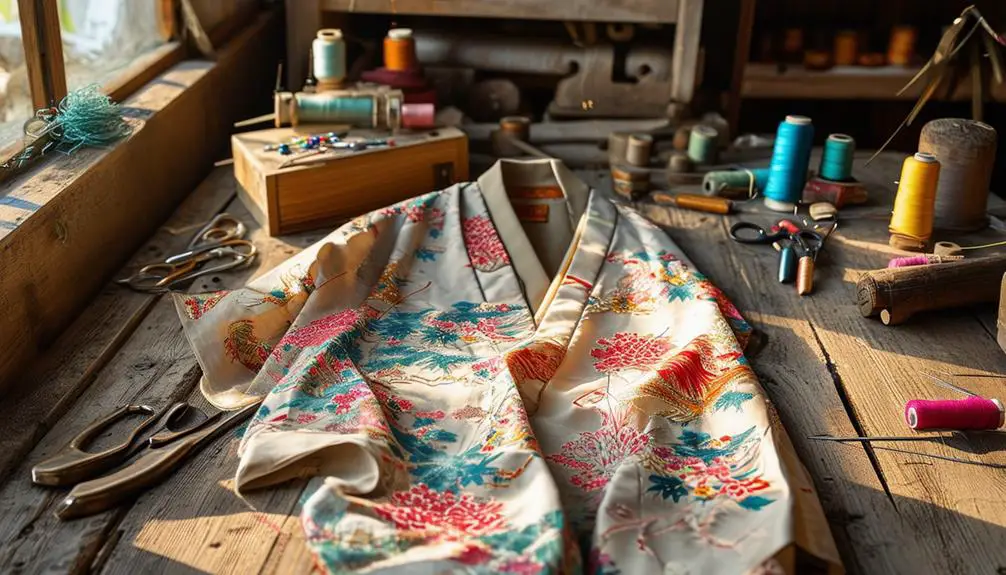
Once you've perfected the hemming technique, you can elevate your vintage kimono by employing a variety of sewing methods that enhance both its functionality and aesthetic appeal.
Start with the stitch-in-the-ditch technique for vertical seams; this guarantees a clean finish without any visible stitches on the outside. It's perfect for maintaining that polished look you desire.
Next, focus on the front openings. Tapering the hems here will eliminate excess fullness, creating a streamlined silhouette that enhances the overall appearance of your kimono.
For the upper edge of the hem, slip-stitching is invaluable. This method allows you to attach it to the lining without securing it to the outer fabric, promoting smooth movement and elegance.
To further personalize your garment, incorporate small decorative stitches that highlight any floral designs. This adds a unique embellishment, showcasing the character of your vintage piece.
As you sew a kimono, remember to follow a step-by-step approach. Check each phase for accuracy and aesthetic appeal; this attention to detail will guarantee your kimono not only looks stunning but also feels comfortable and functional.
Assessing Fabric Condition
Evaluating the fabric condition of your vintage kimono is essential for successful tailoring and restoration. Start by inspecting the fabric closely for any signs of wear, such as fraying edges, discoloration, or stains. These indicators can reveal much about the overall health of the vintage kimono.
Next, check the seams for any weak or damaged areas; reinforcing these spots will help guarantee the garment's longevity.
Pay special attention to linings, particularly those white ones from the late 1940s to early 1960s, as they often exhibit oxidation leading to yellowing or deterioration. This could affect your tailoring choices.
Additionally, review the fabric's texture and weight; older kimonos typically feature lighter, softer materials, which contrast with the stiffer, more rigid fabrics found in modern pieces.
Finally, look for unique fabric techniques like yuzen or jimon. These not only enhance the kimono's beauty but also provide valuable insights into its age and craftsmanship, guiding your restoration approach.
Identifying Kimono Types
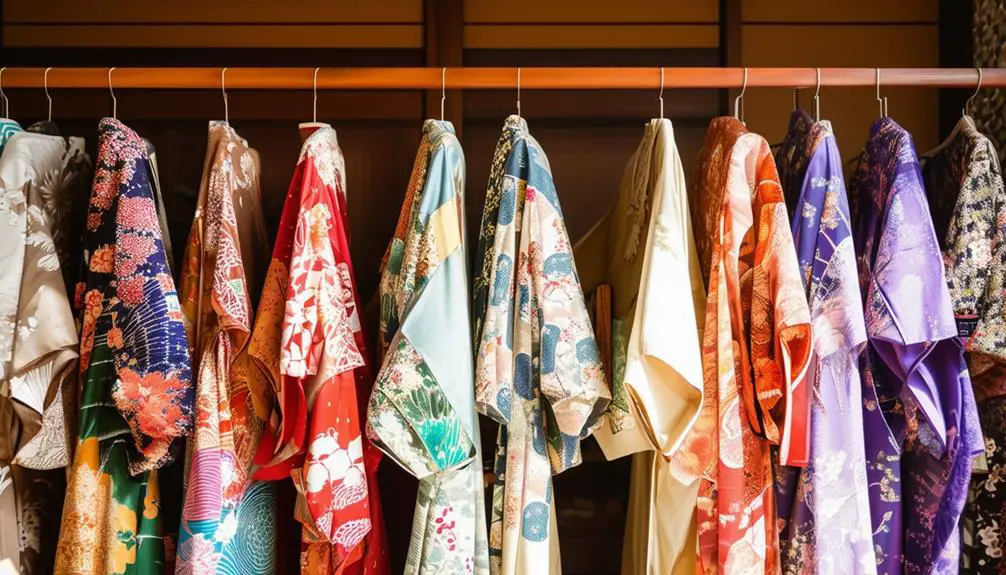
Having assessed the fabric condition of your vintage kimono, the next step involves understanding the various types of kimonos and their unique characteristics. Identifying kimono types is essential for proper tailoring and appreciation.
You'll find kimonos fall into three main categories: casual (komon), intermediate (tsukesage), and formal (furisode). Each type has distinct uses and characteristics.
Pay attention to sleeve length and fabric weight, as these construction elements vary. For instance, furisode kimonos have long, flowing sleeves, indicating their formal nature, while komon styles feature shorter sleeves suited for everyday wear.
Additionally, decorative elements like embroidered patterns or specific fabric techniques can help you differentiate between types. Older kimonos mightn't align with contemporary formality standards; unconventional designs can signal their antique origins.
Moreover, the type of lining or specific design motifs can provide clues about the kimono's age and classification. By recognizing these features, you'll gain a deeper understanding of your vintage piece, making it easier to tailor it to your needs while preserving its unique heritage.
Cultural Context Awareness
Understanding the cultural context of vintage kimonos is vital for anyone looking to appreciate or tailor these garments. Each kimono tells a story, reflecting historical styles, regional variations, and the craftsmanship of different eras. When you explore their original uses—like traditional ceremonies or festivals—you can better inform how to style and wear them today.
Additionally, much like vintage clothing labels, the details found in kimonos can provide insights into their age and origin, enhancing your understanding of their significance.
Consider the techniques that went into creating these textiles, such as yuzen dyeing or kinkoma embroidery. This knowledge enhances your appreciation of their historical value and the immense skill required in their craftsmanship.
However, it's important to approach these garments with sensitivity; recognizing cultural appropriation is key. Wearing or modifying a vintage kimono without understanding its significance risks misrepresentation and diminishes the rich culture behind it.
Engaging with the narratives tied to inherited or thrifted kimonos can deepen your appreciation of personal and cultural histories. Researching their origins fosters dialogue and respect for the traditions they embody.
Community Resources and Support
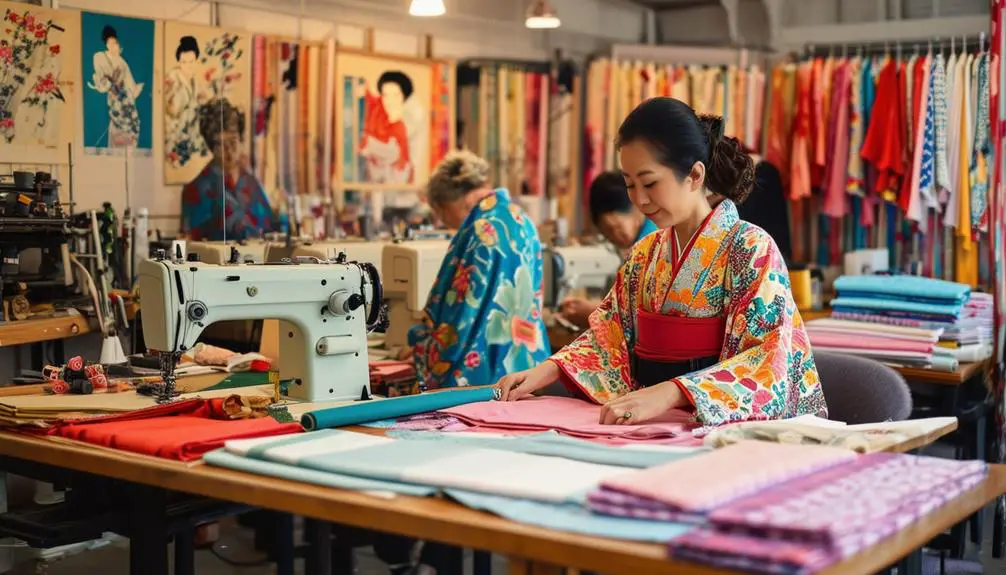
Exploring the rich heritage of vintage kimonos can lead you to a vibrant community enthusiastic to share their knowledge and support. Engaging with this community allows you to enhance your skills and gain insights into tailoring techniques. Community forums are great spaces where you can share experiences and advice, fostering a collaborative environment for sewing enthusiasts.
To further support your journey, consider these valuable resources:
| Resource Type | Description |
|---|---|
| Online Forums | Share techniques and experiences with fellow enthusiasts. |
| YouTube Channels | Visual tutorials on kimono alterations and restoration. |
| Sewing Pattern Sites | Reviews and discussions on suitable patterns for kimonos. |
| Social Media Groups | Exchange tips, photos, and personal stories about sewing. |
Future Content and Engagement
As you dive deeper into tailoring vintage kimonos, you'll find that future content is designed to elevate your skills and connect you with fellow enthusiasts.
Expect step-by-step guides on tying an obi and advanced kimono alterations that will enhance your understanding of working with delicate natural fiber fabrics. Additionally, you'll gain insights into the importance of vintage tag identification for understanding the provenance and value of your garments.
Another tailoring technique you'll explore involves customizing sleeves or hems to create unique silhouettes that reflect your personal style.
Engagement with the community is key. You'll be encouraged to submit your sewing questions and share progress photos, fostering a supportive environment for advice and constructive feedback.
The anticipation for posts on fabric care and restoration techniques highlights the importance of maintaining the integrity of vintage kimonos, ensuring they can be cherished for years to come.
Frequently Asked Questions
Can a Kimono Be Altered?
Yes, you can alter a kimono. Consider adjustments like hemming or altering the sleeves. However, assess the fabric's integrity first to guarantee the changes preserve its original craftsmanship and historical significance.
How Do You Adjust a Kimono?
To adjust a kimono, measure the length, pin it, and mark a cutting line. Cut the outer fabric and lining accordingly, maintaining the traditional silhouette. Use hand sewing techniques for a professional, clean finish.
How to Shorten a Japanese Kimono?
To shorten a Japanese kimono, measure the desired length while wearing it, mark the hem, trim both the outer fabric and lining, then stitch them together for a polished, seamless finish that maintains elegance.
What Is the Difference Between Antique and Modern Kimonos?
You'll notice antique kimonos showcase intricate craftsmanship, unique dyes, and historical patterns, while modern kimonos often emphasize simplified designs and synthetic materials. This distinction highlights the evolution of techniques and aesthetics in kimono production.
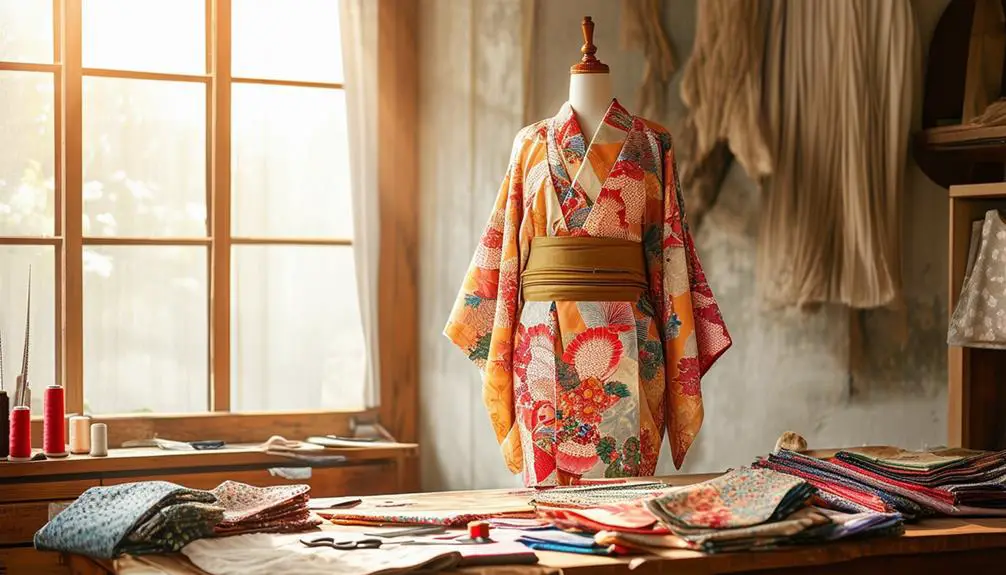




You actually mentioned that exceptionally well.
homepage
With thanks. Numerous data!
casino en ligne
You revealed this terrifically!
casino en ligne
Nicely put. Appreciate it!
casino en ligne
Nicely put. Cheers.
casino en ligne
Thanks, Quite a lot of material.
casino en ligne
You definitely made your point.
casino en ligne
Seriously plenty of useful tips!
casino en ligne
Perfectly voiced indeed. .
casino en ligne
Whoa all kinds of awesome material!
casino en ligne
Your point of view caught my eye and was very interesting. Thanks. I have a question for you.